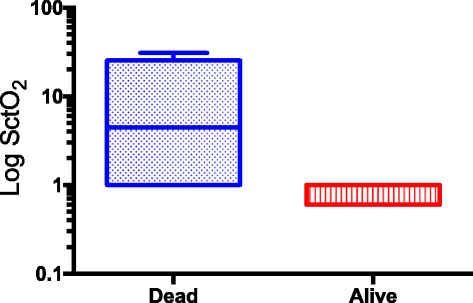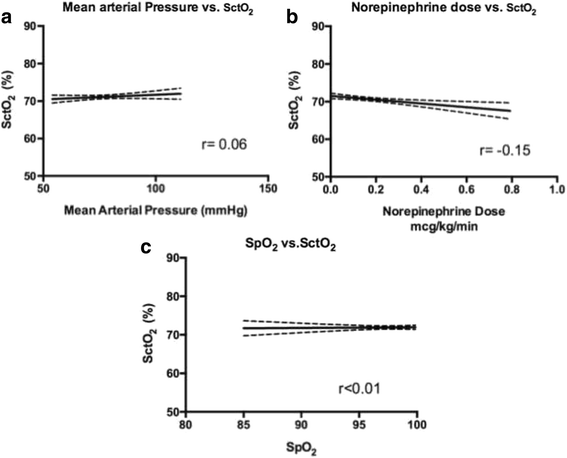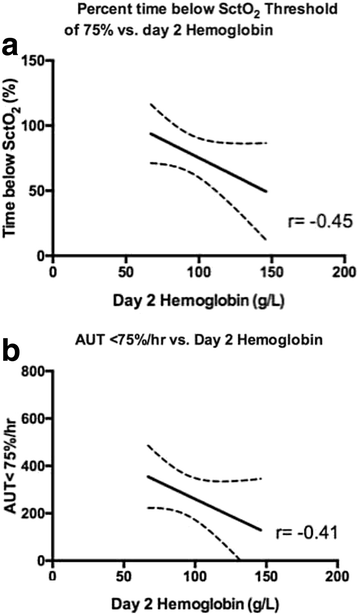Decreases in cerebral saturation in patients with septic shock are associated with increased risk of death: a prospective observational single center study
- PMID: 27366323
- PMCID: PMC4928281
- DOI: 10.1186/s40560-016-0167-y
Decreases in cerebral saturation in patients with septic shock are associated with increased risk of death: a prospective observational single center study
Abstract
Background: The mortality rate from septic shock has been declining. Cerebral hypoxia, measured non-invasively with cerebral oximetry, has been correlated with neurologic and non-neurologic sequelae. Whether cerebral desaturations occur in septic shock patients and what consequences these may have is untested.
Methods: Adult patients with septic shock had cerebral saturation monitoring initiated. The primary objective was to determine if the incidence and magnitude of cerebral desaturations in septic shock patients correlated with delirium. We also compared the incidence and magnitude of cerebral desaturations in patients with septic shock with patients undergoing high-risk non-cardiac surgical procedures, a group known to be at high risk for cerebral desaturations.
Results: Fifteen patients were enrolled. Twelve (80 %) patients had a decrease in SctO2 below 65 %. Delirium was not associated with the area under the curve of an SctO2 of 65 % (p = 0.84). Patients who died of septic shock had more significant decreases in SctO2 than those who survived (p = 0.04). Decreased SctO2 was more common in patients with septic shock and was of greater magnitude than those undergoing high-risk non-cardiac surgery.
Conclusions: Cerebral desaturations occur more commonly and are of a greater magnitude in septic shock patients compared with those undergoing high-risk non-cardiac surgery. There did not appear to be a relationship between the incidence or magnitude of decreases in SctO2 and ICU delirium. Patients who died of septic shock had more significant decreases in SctO2 than patients who survived.
Keywords: Cerebral oxygen saturation; Monitoring; Septic shock.
Figures



Similar articles
-
Prolonged postoperative cerebral oxygen desaturation after cardiac surgery: A prospective observational study.Eur J Anaesthesiol. 2021 Sep 1;38(9):966-974. doi: 10.1097/EJA.0000000000001391. Eur J Anaesthesiol. 2021. PMID: 33186311
-
Association Between Cerebral Desaturation and Postoperative Delirium in Thoracotomy With One-Lung Ventilation: A Prospective Cohort Study.Anesth Analg. 2021 Jul 1;133(1):176-186. doi: 10.1213/ANE.0000000000005489. Anesth Analg. 2021. PMID: 33721874
-
Cerebral tissue O2 saturation during prolonged robotic surgery in the steep Trendelenburg position: an observational case series in a diverse surgical population.J Robot Surg. 2015 Mar;9(1):19-25. doi: 10.1007/s11701-014-0483-y. Epub 2014 Aug 21. J Robot Surg. 2015. PMID: 26530967
-
Cerebral tissue oxygen saturation values in volunteers and patients in the lateral decubitus and beach chair positions: a prospective observational study.Can J Anaesth. 2016 May;63(5):537-43. doi: 10.1007/s12630-016-0604-3. Epub 2016 Feb 4. Can J Anaesth. 2016. PMID: 26846619
-
Does use of intra-operative cerebral regional oxygen saturation monitoring during cardiac surgery lead to improved clinical outcomes?Interact Cardiovasc Thorac Surg. 2009 Aug;9(2):318-22. doi: 10.1510/icvts.2009.206367. Epub 2009 May 15. Interact Cardiovasc Thorac Surg. 2009. PMID: 19447799 Review.
Cited by
-
The Use of Near-Infrared Spectroscopy and/or Transcranial Doppler as Non-Invasive Markers of Cerebral Perfusion in Adult Sepsis Patients With Delirium: A Systematic Review.J Intensive Care Med. 2022 Mar;37(3):408-422. doi: 10.1177/0885066621997090. Epub 2021 Mar 9. J Intensive Care Med. 2022. PMID: 33685273 Free PMC article.
-
Use of cerebral oxygen saturation and hemoglobin concentration to predict acute kidney injury after cardiac surgery.J Int Med Res. 2018 Mar;46(3):1130-1137. doi: 10.1177/0300060517741064. Epub 2017 Dec 6. J Int Med Res. 2018. PMID: 29210291 Free PMC article.
-
Pathomechanisms of Non-Traumatic Acute Brain Injury in Critically Ill Patients.Medicina (Kaunas). 2020 Sep 13;56(9):469. doi: 10.3390/medicina56090469. Medicina (Kaunas). 2020. PMID: 32933176 Free PMC article. Review.
-
In-Hospital Neurologic Complications, Neuromonitoring, and Long-Term Neurologic Outcomes in Patients With Sepsis: A Systematic Review and Meta-Analysis.Crit Care Med. 2024 Mar 1;52(3):452-463. doi: 10.1097/CCM.0000000000006096. Epub 2023 Nov 3. Crit Care Med. 2024. PMID: 37921513 Free PMC article.
-
Vasopressor Therapy and the Brain: Dark Side of the Moon.Front Med (Lausanne). 2020 Jan 10;6:317. doi: 10.3389/fmed.2019.00317. eCollection 2019. Front Med (Lausanne). 2020. PMID: 31998736 Free PMC article. Review.
References
LinkOut - more resources
Full Text Sources
Other Literature Sources

